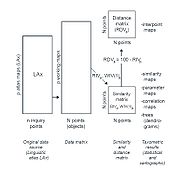
Dialectometry
Encyclopedia

Dialect
The term dialect is used in two distinct ways, even by linguists. One usage refers to a variety of a language that is a characteristic of a particular group of the language's speakers. The term is applied most often to regional speech patterns, but a dialect may also be defined by other factors,...
networks.
The research interest concentrates mainly on the regional distribution of dialect similarities, such as cores of dialect and overlapping zones, which can be labelled according to a more or less slight variance of dialect between bordering locations.
Language atlas
Atlas
An atlas is a collection of maps; it is typically a map of Earth or a region of Earth, but there are atlases of the other planets in the Solar System. Atlases have traditionally been bound into book form, but today many atlases are in multimedia formats...
es serve as an empirical database which document the dialectic profile of a large number of locations in detail.
Different well known numerical classification methodologies are used to abstract and visualise a basic pattern from the immense amount of data found in the language atlases.
Not one solid classification can be expected to result from the calculations; rather, different aspects of the basic pattern being searched for can be discovered by using the different methodologies. Principally speaking, we are more interested in the diversity of the taxometric methodologies, the results and the linguistic interpretations which can be made from them.

